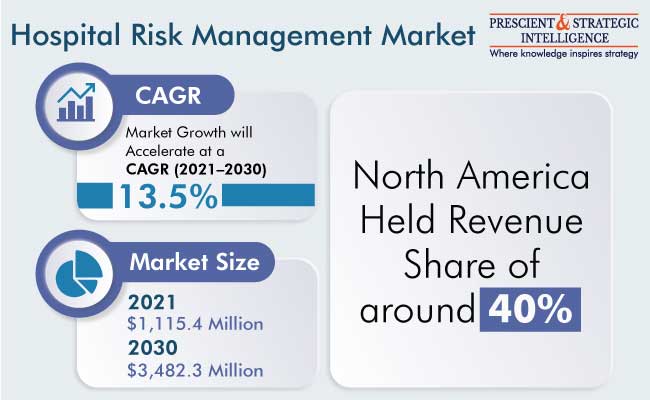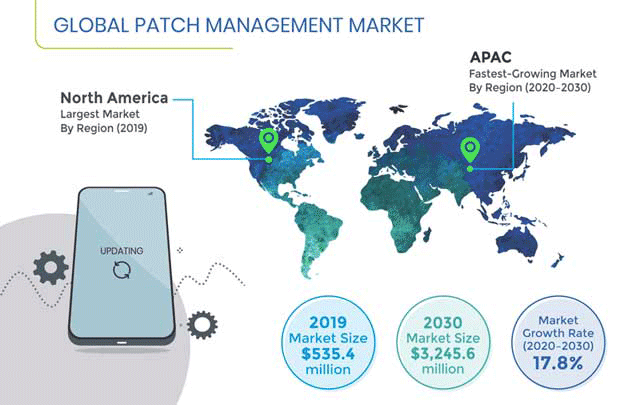Why Will Large Hospitals Drive Hospital Risk Management Market?
The major drivers in the global hospital risk management market are the high prevalence of long-term diseases and the increasing count of medical errors. In 2021, the market was valued at $1,115.4 million, and it is projected to touch $3,482.3 million by 2030. The market will advance at a 13.5% CAGR from 2021 to 2030. Medical errors lead to approximately 3 million deaths every year in comparison to mortality from malaria, HIV, and tuberculosis. Furthermore, extensive governmental support, the increasing integration of information technology in hospitals and clinics, and swift modernization will drive the market.
Based on type, the category projected to advance at the largest CAGR in the hospital risk management market in the forecast period, of about 14%, is risk and compliance management. This can be attributed to the increasing prevalence of hospital-acquired infection, the dire need to lessen the costs of healthcare and increasing awareness of the safety concerns of patients. There was an at least 15% rise in hospital-onset methicillin-resistant Staphylococcus aureus (MRSA) infection and a 25% spike in the count of central line-associated bloodstream infections (CLABSI) in 2020 generating a snowballing demand for risk and compliance management software.
Furthermore, the second-largest shareholder in the hospital risk management market is the workflow management category, accounting for about one-fifth of the total revenue, in 2021. There is huge pressure on the healthcare infrastructure because of the surging incidence of long-term illnesses. Around 70% of the global deaths are because of chronic diseases per year, accounting for approximately the death of 40 million people each year. Apart from offering better effectiveness in medical data control, the category improves internal operations via automation.
Within the deployment segment, the hospital risk management market is bifurcated into the on-premises and cloud-based categories. In 2021, the cloud-based category held a bigger revenue share, of about 80% of the sales revenue, and it is predicted to exhibit the same trend in the forecast period as well by advancing at a 14.0% CAGR in the coming years. This can be credited to minimizing operational costs, coupled with a snowballing demand to trade data among several applications and databases and to promote interoperability within several corporations and healthcare centers and corporations.
By 2030, the biggest share in the hospital risk management market will be held by the large hospital category, accounting for approximately 60% of the total market share. This can be ascribed to a swift integration of EHRs in the healthcare centers., surging hospital expenditure, and an increasing count of large hospitals. To remove the medical errors, there is a dire need for hospital risk management to enhance the operations of EHR systems. The highest hospital bed density is witnessed in Japan with approximately 13 beds for every 1000 people.
In 2021, the global hospital risk management market was led by North America. This is because of the surging adoption of data science to ease the workflow in healthcare centers, the paradigm shift of the on-premises risk management to cloud-based solutions, and the surging count of market players in the U.S. There is a high investment in the healthcare sector due to rising medical errors. Approximately $40 billion is spent on patients bothered with medication errors.
Hence, an increasing count of medical errors and a high prevalence of long-term diseases will provide lucrative opportunities to the market players to gain a competitive edge.
Read More: https://www.psmarketresearch.c....om/market-analysis/h


Patch Management Market To Witness Healthy 17.8% CAGR during 2020–2030
The patch management market stood at $535.4 million in 2019, and it is expected to reach $3,245.6 million by 2030, progressing at a CAGR of 17.8% during 2020–2030 (forecast period). This growth is fueled by the rising demand for up-to-date operating systems (OS)/applications and growing requirement to mitigate vulnerabilities in the software. Owing to a surge in malware attacks, organizations have started deploying patch management solutions to obtain timely updates for their OS/applications. Apart from security, software updates also encompass compatibility updates and bug fixes for application and devices.
A key factor supporting the patch management market growth is the rapid shift toward automation among businesses, to achieve improved productivity, reduce operational costs, and attain optimal efficiency. This key market trend is being observed across all major industry verticals. Information technology (IT) automation accelerates the deployment of missing patches via automated workflows, thereby eliminating the need for manual remediation. In this way, automated processes create consistent processes, enhance security, and protect businesses by improving system insights.
The industry segment of the market is classified into banking, financial services, and insurance (BFSI), information technology (IT) and telecom, government, healthcare, retail, education, and others. Among these, the BFSI category held the largest market share in 2019, and it is expected to showcase the fastest growth in the forecast period. This is because the industry is always under the threat of cyberattacks from internal and external forces. To combat them, the sector has increased its focus on data security and integrating security and vulnerability management solutions.
In 2019, the North American patch management market generated the highest revenue, and it is expected to retain its dominance throughout the forecast period. Of the North American countries, the U.S. is expected to lead the market in the coming years, owing to the escalating number of cyberattacks. Additionally, the country is marked by the presence of numerous patch management solution providers, such as Oracle Corporation, Microsoft Corporation, Qualys Inc., HPE Company, and Ivanti Inc., which have a wide product portfolio.
Furthermore, Europe is expected to exhibit fast growth in the patch management market during the forecast period. This growth will be stimulated by the implementation of stringent laws on data privacy that have a strong focus on data protection and data security. Business organizations in Europe are focusing on customer data protection and aspiring to meet the regulatory compliance requirements, to increase their business in the region. This will, in turn, lead to the wide-scale deployment of these solutions in the coming years.
Due to the presence of multiple players, the patch management market is fragmented in nature. In recent years, key market players have taken strategic measures such as product launches, geographical expansions, partnerships, and mergers and acquisitions to consolidate the competition. For instance, Qualys Inc. introduced Patch Management (PM) in February 2019. PM is a cloud application that offers improved capabilities for automated patch deployment, which allows customers to orchestrate the complete lifecycle vulnerability of the OS and third-party software in a transparent manner.
Thus, the increasing vulnerabilities to OSs and rising focus on automation will fuel the market growth in the forecast period.
Read More: https://www.psmarketresearch.c....om/market-analysis/p
European Tunnel Automation Market To Prosper in Coming Years
The global tunnel automation market reached a revenue of $3.5 billion in 2020, and it is predicted to exhibit huge expansion during 2021–2030 (forecast period). The major factors fueling the expansion of the market are the surging requirement for improved road safety and security solutions, owing to the rising incidence of road accidents, increasing incorporation of tunnel automation systems with various advanced technologies, such as internet of things (IoT) and cloud storage, adoption of analytics in tunnel management, and surging number of tunnel construction projects across the world.
With the rising prevalence of road accidents, road safety is becoming a major concern area for governments and organizations all over the world. According to the World Health Organization (WHO), road accidents claim the lives of around 1.3 million people every year. Furthermore, the organization reported that road accidents cost a large number of countries 3% of their gross domestic product (GDP) and they are the leading cause of deaths for young adults aged between 5 and 29 years and children across the world.
Due to the aforementioned factors, the governments of many countries are making huge investments in advanced technologies, such as tunnel automation, that can massively enhance security, lighting, air conditioning, ventilation, and surveillance in tunnels, thereby improving road safety. Besides, the increasing adoption of cloud-based automation and IoT-incorporated automation solutions in tunnels is also driving the growth of the tunnel automation market. Tunnel automation systems are being increasingly integrated with innovative technologies, such as cloud computing, data analytics, and IoT, in order to provide customers with an edge over conventional manual management methods.
The market is categorized into highway and roadway tunnels and railway tunnels, depending on tunnel type. Of these, the railway tunnels category contributed higher revenue to the market in 2020. This is ascribed to the various benefits of railway tunnel automation solutions, such as reduced security and safety threats and enhanced efficiency of tunnel operations. Fire and safety, lighting and power supply, ventilation, signalization, communication, and air conditioning systems are some of the major components of these tunnel automation systems.
When component is taken into consideration, the tunnel automation market is classified into heating, ventilation, and air conditioning (HVAC), signalization, and lighting and power supply. Amongst these, the HVAC category dominated the market in 2020, and it is predicted to demonstrate the highest CAGR in the market throughout the forecast period. This is credited to the extensive usage of HVAC components in tunnel automation. Moreover, the requirement for proper ventilation of heat and several harmful gases that are emitted by trains and vehicles that pass through the tunnels is also fueling the growth of the category.
Globally, Europe will dominate the tunnel automation market during the forecast period, as per the forecast of P&S Intelligence, a market research company based in India. This is attributed to the several projects and initiatives launched by the governments of regional countries for optimizing transportation systems, existence of mountain ranges, surging incidence of road accidents, rising requirement for public transportation systems, and growing public awareness about road and rail safety in the region.
Hence, the market will register rapid expansion in the coming years, mainly because of the rising requirement for improved tunnel and road safety and the growing adoption of advanced technologies in tunnel automation systems across the world.
Read More: https://www.psmarketresearch.c....om/market-analysis/t


